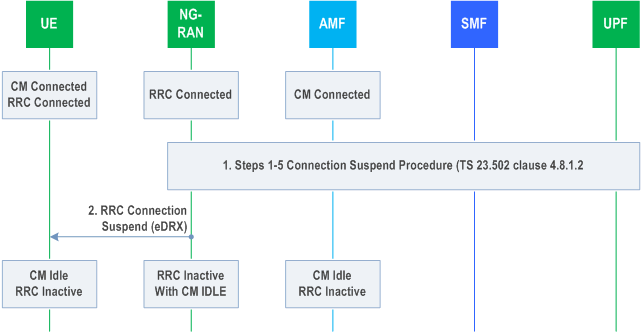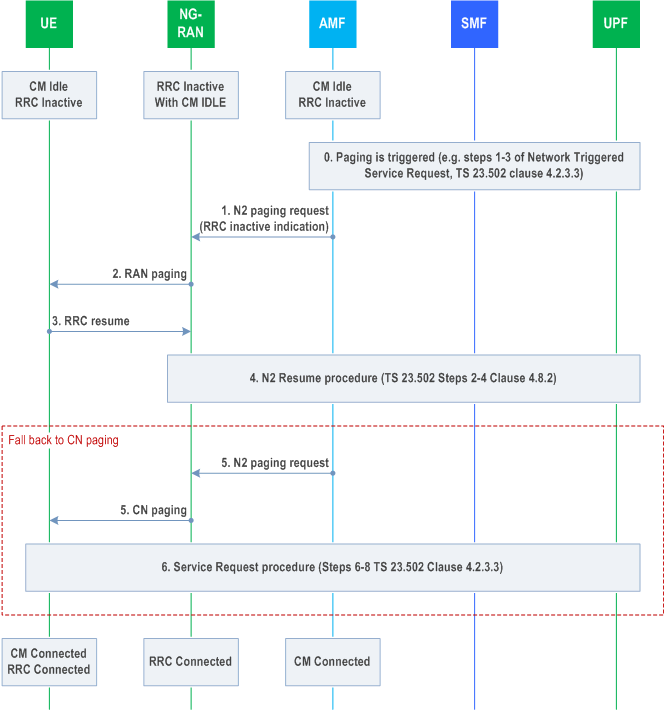Content for TR 23.700-68 Word version: 18.1.0
6.4 Solution #4: RRC Inactive with CM-IDLE for eDRX > 10.24s
6.4.1 Description
6.4.2 Procedures
6.4.2.1 N2 suspend for UE entering RRC inactive with eDRX > 10.24s
6.4.2.2 UE paging and resume
6.4.3 Impacts on services, entities and interfaces
...
...
6.4 Solution #4: RRC Inactive with CM-IDLE for eDRX > 10.24s p. 20
6.4.1 Description p. 20
This solution proposes, for the case of RRC Inactive and eDRX > 10.24s, to combine:
When the UE is moved to CM-IDLE with RRC-Inactive, the NG-RAN initiates N2 suspend procedure towards the 5GC. When the UE moves back to RRC-Connected, the NG-RAN initiates N2 resume procedure.
When the UE is in CM-IDLE with RRC Inactive, all currently defined 5GC features related to UE being unreachable for CM-ILDE with extended DRX apply with the following addition:
- On the RAN/RRC side, maintain RRC-Inactive state for fast resume procedure.
- On the CN/NAS side, use CM IDLE which implicitly already supports proper handling of high latency communications (HLcom) when the UE is unreachable for an extended period of time.
- The AMF may send N2 paging message only towards the NG-RAN node where N2 suspension occurred with indication of paging in RRC Inactive with CM_IDLE, and the NG-RAN node performs RAN paging in the RAN notification area.
- The AMF may e.g. if initial attempt(s) to reach UE using RAN paging fail, try regular CN paging, i.e. send N2 paging message without indication of RRC Inactive with CM-IDLE. In this case the RAN performs regular CN paging.
- If the UE receives RAN paging, it attempts RRC resume procedure.
- If RRC resume fails the UE falls back to CM-IDLE with RRC Idle and initiates RRC connection establishment request.
- If the UE receives CN paging, it moves to CM-IDLE with RRC Idle and initiates RRC connection establishment request.
- If the UE steps outside RAN notification area, the UE initiates RAN Notification Area Update.
- The UE performs periodic RAN notification Area Update.
- The UE performs periodic registration update.
6.4.2 Procedures p. 21
6.4.2.1 N2 suspend for UE entering RRC inactive with eDRX > 10.24s p. 21

Step 0.
Based on the information received from the AMF, the NG-RAN node may decide to move the UE to CM-IDLE with RRC inactive if the NG-RAN intends to configure the UE with extended DRX longer than 10.24 seconds.
Step 1.
The NG-RAN shall initiate N2 suspend procedure as defined in clause 4.8.1 of TS 23.502 with the addition of: NG-RAN provides RRC Inactive with CM-IDLE indication and provides RRC inactive eDRX cycle length and PTW. The AMF shall enter CM-IDLE with RRC inactive state.
Step 2.
The NG-RAN initiates RRC release with suspend indication towards the UE with eDRX > 10.24s and RRC Inactive with CM-IDLE indication. The UE and the NG-RAN enters CM-IDLE with RRC inactive.
6.4.2.2 UE paging and resume p. 21
When the UE is in CM-IDLE with RRC Inactive, all mobile terminated data handling, high latency communication, and network initiated procedures follow the procedures defined in TS 23.502 when the UE is in CM-IDLE except for UE paging and connection resume.

Step 1.
(Optional) Fallback to CN paging
There is a trigger to page the UE, e.g. due to mobile terminated data, steps 1-3 of Network Triggered Service Request (clause 4.2.3.3 of TS 23.502,). The AMF determines the start of PTW as provided by NG-RAN, and sends N2 paging message only towards the NG-RAN node where N2 suspension occurred with indication of paging in RRC Inactive with CM_IDLE.
Step 2.
The NG-RAN initiates RAN paging in the RAN notification area.
Step 3.
When the UE receives RAN paging, it initiates RRC resume procedure from RRC inactive.
Step 4.
The NG-RAN proceeds with Steps 2-4 of clause 4.8.2 of TS 23.502.
6.4.3 Impacts on services, entities and interfaces p. 22
UE:
- Support of RRC inactive with CM-IDLE.
- Extend N2 Suspend and N2 Resume procedures to CM-IDLE with RRC inactive with eDRX cycle and PTW indication.
- Extend the RRC Release message to release the UE to RRC-Inactive with CM-Idle.
- Support AMF triggered RAN paging.
- Support of RRC inactive with CM-IDLE.
- Support of N2 paging with RRC inactive indication to trigger RAN paging.
- Extend the RRC-Inactive assistance information with the support for RRC-Inactive with CM-idle indication.
- Extend N2 suspend and N2 resume procedure to enter CM-IDLE with RRC inactive and CM-CONNECTED respectively.